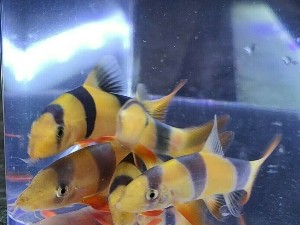
Chromobotia macracanthus (Clown Loach Fish for Sale)

Loaches have Great Personalities
Loaches belong to the Balitoridae, Botiidae, Cobitidae, Gastromyzontidae, Nemacheilidae, Serpenticobitidae, and Vaillantellidae families of bottom-dwelling fish. Few aquarium fish have the kind of personality that many loach species have, and many aquarists engage with their loach companions on a regular basis. Loaches may be found over much of Asia, from tropical to temperate zones, and can grow to be over a foot long.What is the Natural Habitat of Loaches like?
Depending on the species, loaches may be found in rivers as well as a range of slow and fast-moving streams. Gravel, pebbles, and smooth stones abound on the bottom, however sandy regions may also be found. Plants are rare to non-existent in most ecosystems.Are there Special Water Requirements for Loaches?
Loaches may be found in a wide range of water conditions, but the majority of them will survive in a typical aquarium. The pH should be between 6.0 and 8.0, and the alkalinity should be between 3 and 10 degrees dKH (50 to 175 ppm). Clean, well-oxygenated water with a moderate to vigorous flow is required for all loaches. Species have different temperature needs. Use an Aquarium Heater to maintain correct water temperature if the aquarium is housed in a room below the minimal temperature. Maintain adequate filtration and use an Aquarium Water Changer or Siphon Vacuum Gravel Cleaner to do a 10% water exchange every week or a 25% water exchange every two weeks. Before refilling your aquarium, be sure to treat the tap water with Water Conditioner.What are the Tank Requirement for Loaches?
The size of your aquarium will be determined by the kind of loach you intend to maintain. The optimum substrate for most loaches is sand or fine gravel. To mimic the natural habitat of animals that dwell in fast-moving streams, add smooth pebbles and rocks and give a moderate to strong flow. Caves, hollow logs, and other size-appropriate hiding places should be accessible in the aquarium since many loaches are secretive.How is the Behavior of Loaches in Groups?
Loaches are social, so buy them in groups of six or more if feasible. With so many kinds to pick from, there is one that is perfect for you, regardless of the size of your aquarium or the sort of fish you have. The majority of loaches are calm and thrive in communal tanks. Some members of the Botiidae family, on the other hand, may become rowdy and attack smaller or slower-moving fish. Larger, more energetic fish are preferable for these species. Before buying a fish, do some study or consult an aquarium professional.What is a Typical Diet for Loaches?
While most loaches will eat a range of foods, those who live in fast-moving water, such as Hill Stream loaches, should be given extra treatment. Many of these fish eat algae, cyanobacteria, and other microorganisms that live on the bottom of the sea. Only mature aquariums with enough of suitable rockwork should be used to house these species. Rotate their meals on a regular basis for optimal results, and only give them once or twice a day what they can ingest in under 2 minutes. Prepared aquarium foods include earthworms, krill, sinking pellets, grazing wafers and freeze dried bloodworms.Can you Breed Loaches in the Aquarium?
Few loaches have been bred in home aquariums, and the majority of reports are unintentional. Hormones have been used successfully by certain commercial breeders in Southeast Asia to get loaches to spawn.

$24.99



